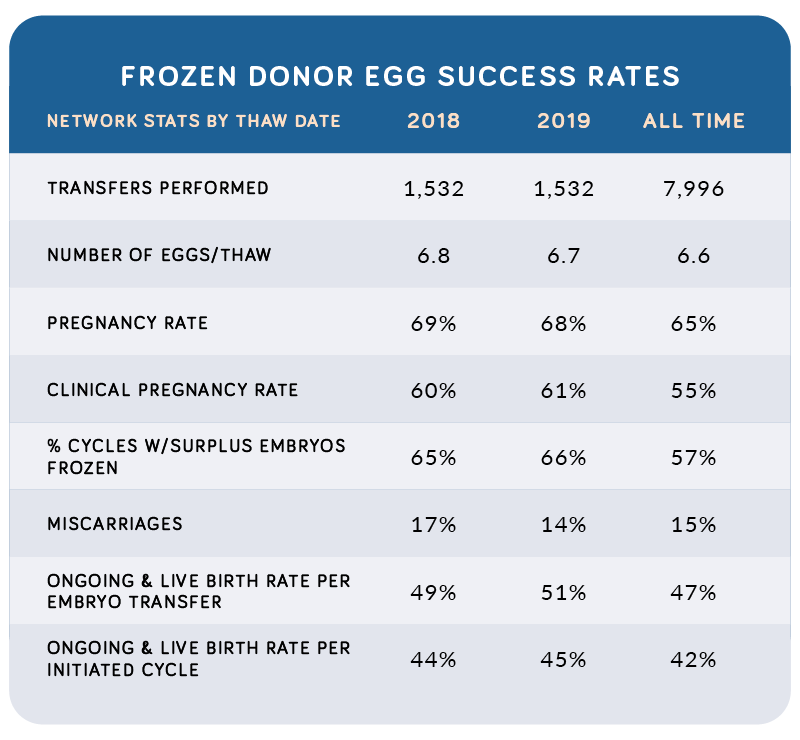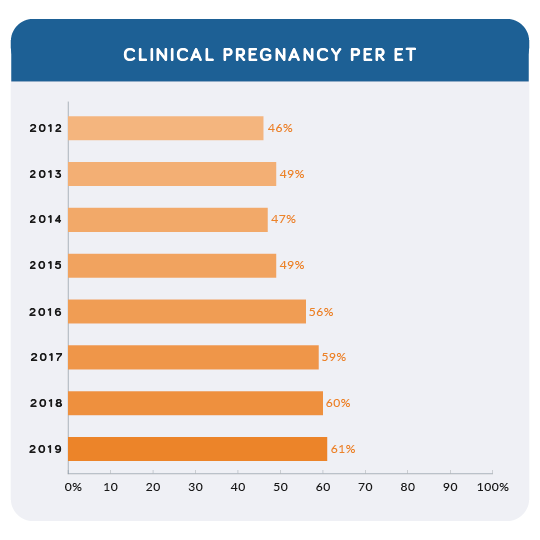How Successful is Using Frozen Donor Eggs with Donor Egg Bank USA?

Since 2012, Donor Egg Bank USA has been a leader in providing frozen donor egg services to hopeful individuals and couples who dream of having a family.
We’ve built an extensive network encompassing more than 210 top-rated fertility practices. Using our advanced understanding of the egg donation industry, paired with the resources and experience established through our network connections, we ship frozen donor eggs to facilities both nationally and internationally.
We have achieved industry-leading results and are honored to have thawed our 8,000th set of eggs.
To better understand your chances of pregnancy success when using our high-quality frozen donor eggs, we’ve put together a collection of answers to the most commonly asked questions we hear regarding our eggs and policies.

On DEB USA’s Success Rates:
What’s an Average Egg Lot Size?
At Donor Egg Bank USA, we commit ourselves to only shipping egg lots that include high-quality, mature eggs. These offer improved chances of becoming better developed embryos and successful pregnancies. Our frozen donor egg lots generally range from 5-8 eggs.
What’s the Average Number of Eggs Thawed?
The average number of eggs shipped and thawed in a given lot is between 6-7. In 2019, an average of 6.7 eggs were thawed per cycle.
What Percentage of Cycles Have Surplus Embryos Frozen for Future Use?
While not every cycle ends with surplus embryos, many Donor Egg Bank USA recipients receive more embryos than they can use in a cycle. While our all-time average for surplus embryos is 57%, 2019 saw a significant increase, with 66% of individuals having extra to freeze for future use.
Does DEB USA Require its Network Partners to Report All Cycles?
Absolutely! We believe our hopeful parents deserve the most up-to-date information regarding our success rates and cycle information. We request that our network partners report every cycle to ensure accurate statistics.
What is the Frozen Donor Egg Success Rate Using Donor Eggs from DEB USA?
Compared to traditional IVF, which has an average success rate of 39.6% per transfer, individuals who use DEB USA donor eggs to conceive see an all-time average of 47% success from the first transfer.
What’s the Difference Between Pregnancy Rate and Clinical Pregnancy Rate?
Pregnancy rate includes any cycles where there was a positive pregnancy test, meaning biochemical pregnancies are also included. Clinical pregnancy only includes pregnancies that have developed enough to have a visible fetal sac and/or a heartbeat. 
What’s the Difference Between Ongoing and Live Birth Rate Per Embryo Transfer vs. Ongoing and Live Birth Rate Per Initiated Cycle?
On-going and live birth rate per transfer refers to how many on-going pregnancies and live births result from each transfer, whereas on-going and live birth rate per initiated cycle includes results from cycles that never made it to transfer.
What is the Miscarriage Rate with Frozen Donor Eggs?
Thanks to technological improvements over the last several years, the number of miscarriages experienced with frozen donor egg usage has seen a consistent decline. While approximately 17% of clinical pregnancies resulted in miscarriages in 2018, that number dropped to 14% in 2019. The average rate of miscarriage from using frozen donor eggs is 15%, which is very similar to the rates seen in natural pregnancies.
What is a Freeze All Cycle? How Often Do They Occur?
On average, 17% of individuals and couples looking to use frozen donor eggs will have a freeze all cycle. This type of cycle happens when the eggs are fertilized and the resulting embryos are frozen for later use. None of the embryos are transferred at the time of the egg thaw in a freeze all cycle.
This type of option is becoming increasingly popular among fertility clinics, with some starting to do freeze all cycles for a majority of cases. The most common reason is so patients can have genetic testing performed on the embryos before transfer.
On DEB USA’s Blastocyst Guarantee:
Does DEB USA Offer Any Guarantees?
Our team understands that deciding to use frozen donor eggs is not always easy. For this reason, DEB USA is committed to excellence and proud to offer potential recipients a blastocyst guarantee. This policy ensures patients will receive one or more blastocyst(s) for transfer, freezing, or biopsy.
Does DEB USA Guarantee Euploid Embryos?
At this time, we do not guarantee euploid embryos.
What Happens if a Blastocyst Isn’t Available?
DEB USA stands by the quality and viability of our frozen donor eggs. That being said, there are times when no embryos develop to blastocyst stage after your egg lot is shipped and fertilized. In these cases, our team will provide a new egg lot under your chosen financial plan.
Other General Questions:
What’s the Difference Between Using Fresh Donor Eggs and Frozen Donor Eggs?
While a frozen donor egg cycle will utilize eggs which have already been screened and collected, a fresh cycle relies on finding a donor in your local area and starting the process from scratch.
Fresh donor egg cycles are significantly more costly than frozen donor egg cycles. Recipients must not only pay for the medical treatments of the donor and themselves, but they’re also required to supplement any lost income and travel fees, as needed.
Fresh donor eggs also require a significant time commitment for the egg recipient and come with a high risk of donors screening out in the process. This is in large part due to the multitude of moving parts involved with utilizing fresh donor eggs. Not only must the donor and recipient’s cycles be perfectly synced for a successful transfer to occur, but the intended parent must also have a donor reliable enough to attend all of her appointments and take the required medications correctly.
The advantage of frozen donor eggs from Donor Egg Bank USA is since quality eggs have already been retrieved, a potential recipient doesn’t need to worry about the donor and syncing their cycle with her. Hence, this allows the intended parent to start and focus on their treatment plan when it’s most convenient for them.
Are Fresh or Frozen Donor Eggs a Better Choice?
In decades past, fresh donor eggs generated better results for hopeful parents. However, with the discovery of an advanced flash-freezing technique known as vitrification, the success rates between fresh and frozen donor eggs are now equal.
With this information in mind, it’s easy to see why frozen donor eggs are the more optimal solution for hopeful individuals wanting to conceive. Unless you have a friend or family member who’s offered to donate their eggs, a fresh donor egg cycle is more mentally, physically, and financially taxing on potential parents.
What Measures is DEB USA Taking Against Covid-19?
Given the stressful times we are living in and the rapid number of Covid-19 cases popping up throughout the United States, it’s no wonder our patients are questioning what we’re doing to minimize risks.
Based on the recommendations put forth by the AATB Physician's Council, which are based on data reported by the Centers for Disease Control (CDC), the DEB USA team and our partner clinics are enhancing our donor egg screening processes to avoid potential exposure.
Our teams are deferring possible donors with the following circumstances:
- Anyone exhibiting cough, fever, or shortness of breath within 28 days of donation
- Anyone with symptoms of respiratory illness that have not been proven Covid-19 negative
- Anyone with a confirmed investigation, or who is a ‘Person Under Investigation’
- Anyone who’s been in close contact with a person who’s Covid-19 positive
Is Donor Egg Bank USA the Right Choice for You and Your Family?
For the staff of DEB USA, it is our greatest privilege to help individuals struggling with infertility form the family they’ve always wanted. In 2019 alone, our network partners performed 1,185 embryo transfers for hopeful intended parents who used our services to find an egg donor.
Let our success rates and expertise speak for themselves. If you’re interested in using donor eggs, why not choose the most reliable network of experts to help you through the process?
If you’re interested in getting started, or if you would like more information on our frozen donor egg network’s success rates, please give us a call today or fill out our online form.
Categories
Latest Posts
- Pride, Parenthood and Possibility: A Guide for Gay Dads Using Frozen Donor Egg
- Victoria’s Story: Choosing Donor Egg and Beyond
- Heartbreak, jealousy, and then one ‘golden egg’. How actress Camille Guaty finally became a mom with donor egg
- Empowering Your Family Dreams: Accessing Fertility Coverage Made Simple
- Donor Egg Bank USA’s Partner Summit 2024
- Planning, Painting and Picking: A Donor Egg Bank USA Employee’s Journey to Motherhood
- Real Stories: A Path to Parenthood Through Donor Eggs
- Mental Health and Infertility 101: What You Should Know
- Mark Yourself as a Resource During National Infertility Week®
- 5 Reasons It’s Not Your Fault You’re Not Pregnant
Comments
Share Your Thoughts